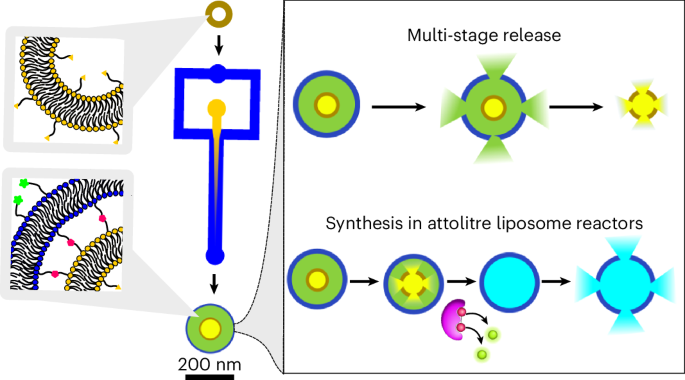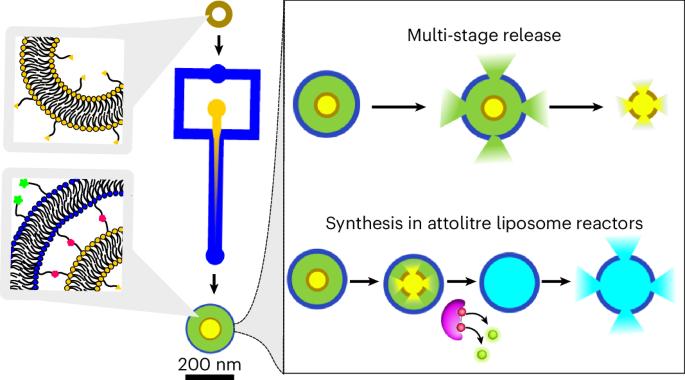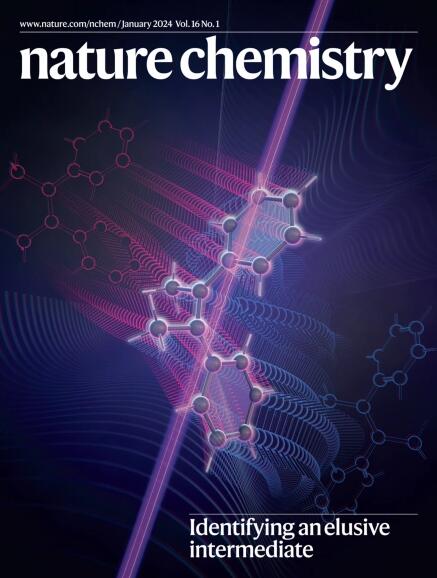Engineering a nanoscale liposome-in-liposome for in situ biochemical synthesis and multi-stage release
IF 19.2
1区 化学
Q1 CHEMISTRY, MULTIDISCIPLINARY
引用次数: 0
Abstract
Soft-matter nanoscale assemblies such as liposomes and lipid nanoparticles have the potential to deliver and release multiple cargos in an externally stimulated and site-specific manner. Such assemblies are currently structurally simplistic, comprising spherical capsules or lipid clusters. Given that form and function are intertwined, this lack of architectural complexity restricts the development of more sophisticated properties. To address this, we have devised an engineering strategy combining microfluidics and conjugation chemistry to synthesize nanosized liposomes with two discrete compartments, one within another, which we term concentrisomes. We can control the composition of each bilayer and tune both particle size and the dimensions between inner and outer membranes. We can specify the identity of encapsulated cargo within each compartment, and the biophysical features of inner and outer bilayers, allowing us to imbue each bilayer with different stimuli-responsive properties. We use these particles for multi-stage release of two payloads at defined time points, and as attolitre reactors for triggered in situ biochemical synthesis. Most lipid nanoparticles are structurally simplistic, existing as single-compartment assemblies. Now, a microfluidic technology to create liposomes-in-liposomes—with full control over particle features, such as the composition of each membrane, the intermembrane distance and payload of each compartment—has been developed. These particles are exploited for multi-stage release and in situ enzymatic synthesis within the particle’s attolitre volume.


设计纳米级脂质体中的脂质体,实现原位生化合成和多级释放
脂质体和脂质纳米颗粒等软物质纳米级组合体有可能以外部刺激和特定部位的方式输送和释放多种载体。目前,这类组装体结构简单,由球形胶囊或脂质团块组成。由于形式和功能相互交织,这种结构复杂性的缺乏限制了更复杂特性的发展。为了解决这个问题,我们设计了一种结合微流体技术和共轭化学的工程策略,以合成具有两个离散隔室的纳米级脂质体,我们称之为同心体。我们可以控制每个双分子层的成分,调整颗粒大小和内外膜之间的尺寸。我们可以指定每个隔室中封装货物的特性,以及内外双分子层的生物物理特征,从而使每个双分子层都具有不同的刺激响应特性。我们利用这些颗粒在规定的时间点多级释放两种有效载荷,并将其作为触发原位生化合成的attolitre反应器。
本文章由计算机程序翻译,如有差异,请以英文原文为准。
求助全文
约1分钟内获得全文
求助全文
来源期刊

Nature chemistry
化学-化学综合
CiteScore
29.60
自引率
1.40%
发文量
226
审稿时长
1.7 months
期刊介绍:
Nature Chemistry is a monthly journal that publishes groundbreaking and significant research in all areas of chemistry. It covers traditional subjects such as analytical, inorganic, organic, and physical chemistry, as well as a wide range of other topics including catalysis, computational and theoretical chemistry, and environmental chemistry.
The journal also features interdisciplinary research at the interface of chemistry with biology, materials science, nanotechnology, and physics. Manuscripts detailing such multidisciplinary work are encouraged, as long as the central theme pertains to chemistry.
Aside from primary research, Nature Chemistry publishes review articles, news and views, research highlights from other journals, commentaries, book reviews, correspondence, and analysis of the broader chemical landscape. It also addresses crucial issues related to education, funding, policy, intellectual property, and the societal impact of chemistry.
Nature Chemistry is dedicated to ensuring the highest standards of original research through a fair and rigorous review process. It offers authors maximum visibility for their papers, access to a broad readership, exceptional copy editing and production standards, rapid publication, and independence from academic societies and other vested interests.
Overall, Nature Chemistry aims to be the authoritative voice of the global chemical community.
 求助内容:
求助内容: 应助结果提醒方式:
应助结果提醒方式:


